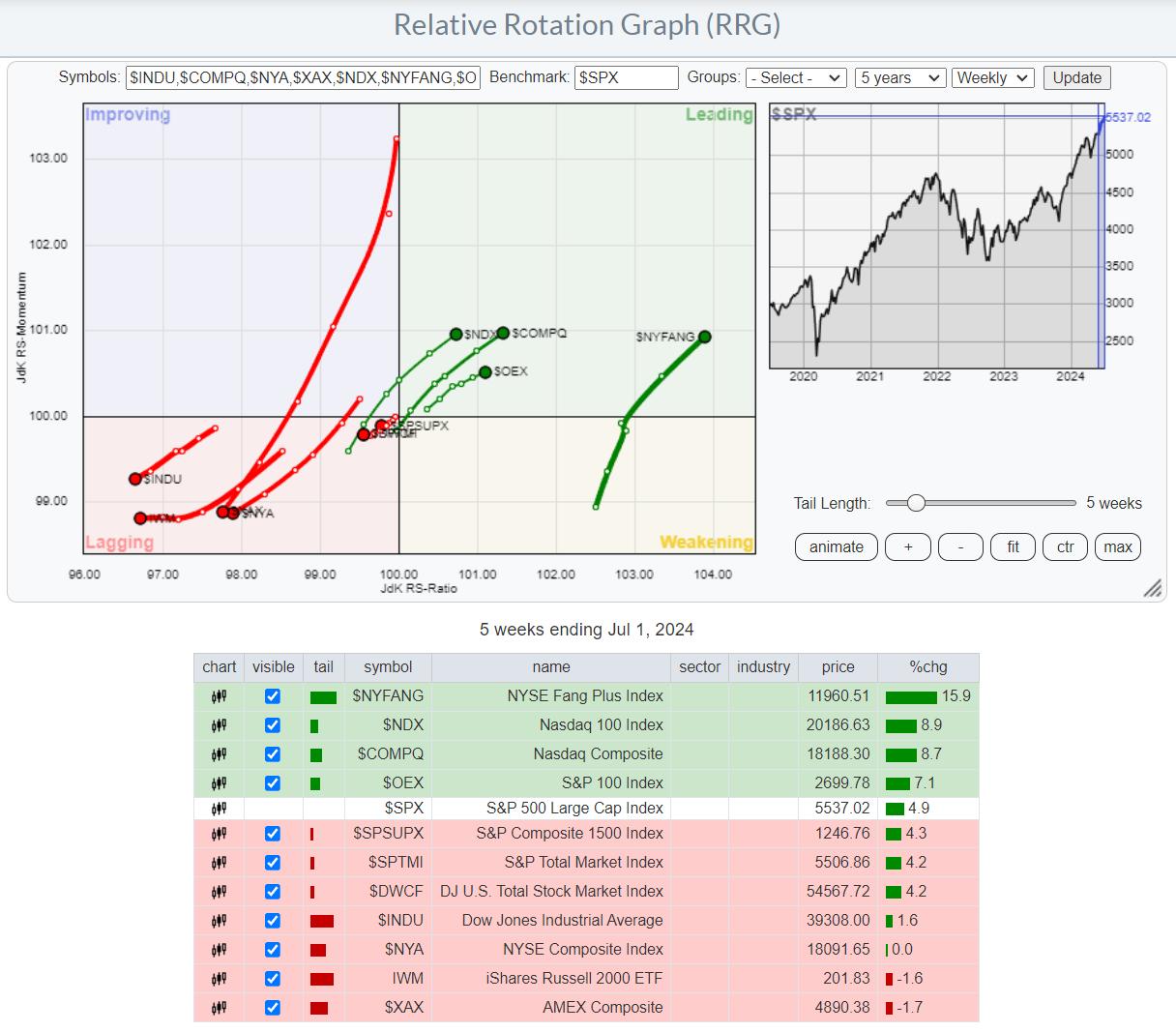KEY
TAKEAWAYS
- Looking at market breadth from a different perspective
- Plotting major US stockmarket indices on a Relative Rotation Graph
- Even inside the NY FANG index the base is narrow.
Many chatter and mentions of weak or narrow breadth are floating around these days. I plead guilty as well.
I want to approach this from another angle using some of the major US stock indices for this article.
I usually examine the market using sectors or a growth/value/size breakdown, with the S&P and Dow Jones indices playing a major role. But there is more.
Major US Stockmarket Indices
The first RRG shows the rotation of some of the major US stock market indices against the benchmark S&P 500.
I have added the table below the graph as a legend for the symbols on the tails, as they may not be so mainstream.
The tails and the accompanying performances are shown over a five-week period. All the broader indices are camping inside the lagging quadrant and traveling at a negative RRG-Heading, while the narrower-based indices are inside the leading quadrant and on a strong, 0-90 degrees RRG-heading.
There is no index inside the improving quadrant or the weakening quadrant. This indicates the clear split between these two groups.
The only exception concerning “broader” indices is the Nasdaq Composite index ($COMPQ) with 2500 stocks. However, this index is, very, heavily tilted toward the software & It services and technology equipment stocks. The exception on the “narrower” indices is the DJ Industrials index, which has a relatively low exposure to the technology sector, also because of its price-weighted approach.

When I remove $COMPQ and $INDU and set the tail length to 3 weeks for better visibility, this is the chart that remains. I found it interesting that the further you go to the right, the smaller the index becomes in terms of stocks in the index, not necessarily in market capitalization.
NY FANG Beats All
The next step was to zoom in on the rotation of $NYFANG.

When I set the tail length to 30 weeks, the exact same indices show up on top, with $NYFANG handsomely beating all other indices in this group. When you open up this RRG, live (click on the chart), you have to scroll back to 3/13/2023 before $NYFANG drops from the first place over a 30-week period. That’s a pretty impressive period (trend).
Even Inside The NY FANG Index, The Base is Narrow
And finally, let’s zoom in on the members of the NY FANG index.

This RRG shows the rotation for the NYFANG members against $NYFANG. The first observation is a high concentration of stocks inside the lagging quadrant. Except for SNOW and AMD, they have beaten the S&P 500 over this 5-week period. But not $NYFANG. Only TWO stocks have outperformed $NYFANG over this 5-week period: TSLA and NVDA.
Looking back, 30 weeks shows that only NVDA, META, and NFLX have beaten $NYFANG.
The big spread between the top and bottom of the list, +38.4% for TSLA and -1.8 % for AMD, also shows that the performances are very stock-specific. Even within the same sector, big differences show up. MSFT (Technology/ software) shows an 11% gain vs. SNOW in the same group, with a 4.9% gain.
The difference is even bigger in semiconductors. NVDA (Technology/semiconductors) +17% against a loss of 1.8% for AMD in the same group.
The main takeaway from all this, IMHO, is that the foundation is indeed narrow and concentrated in large cap, offensive/growth stocks. This group of stocks can still keep the S&P 500 going up or at least remain sideways during transition periods. This is caused by individual stocks rotating through very strong, relative trends.
As long as this situation persists, I believe it will be much more important to focus on individual stocks first, then sectors, and only then the broader market.
Happy Fourth Of July, –Julius
Julius de Kempenaer
Senior Technical Analyst, StockCharts.com
Creator, Relative Rotation Graphs
Founder, RRG Research
Host of: Sector Spotlight
Please find my handles for social media channels under the Bio below.
Feedback, comments or questions are welcome at Juliusdk@stockcharts.com. I cannot promise to respond to each and every message, but I will certainly read them and, where reasonably possible, use the feedback and comments or answer questions.
To discuss RRG with me on S.C.A.N., tag me using the handle Julius_RRG.
RRG, Relative Rotation Graphs, JdK RS-Ratio, and JdK RS-Momentum are registered trademarks of RRG Research.

Julius de Kempenaer is the creator of Relative Rotation Graphs™. This unique method to visualize relative strength within a universe of securities was first launched on Bloomberg professional services terminals in January of 2011 and was released on StockCharts.com in July of 2014.
After graduating from the Dutch Royal Military Academy, Julius served in the Dutch Air Force in multiple officer ranks. He retired from the military as a captain in 1990 to enter the financial industry as a portfolio manager for Equity & Law (now part of AXA Investment Managers).
Learn More





